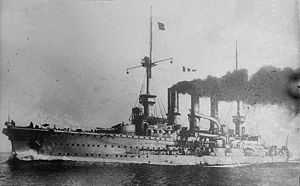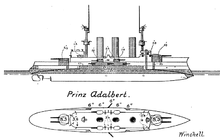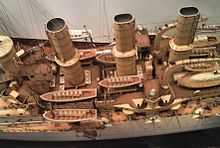Prinz Adalbert-class cruiser
 SMS Prinz Adalbert | |
| Class overview | |
|---|---|
| Name: | Prinz Adalbert |
| Operators: |
|
| Preceded by: | Prinz Heinrich unique armored cruiser |
| Succeeded by: | Roon-class armored cruiser |
| Planned: | 2 |
| Completed: | 2 |
| General characteristics | |
| Type: | Armored cruiser |
| Displacement: | 9,087 tons (9233 t) normal; 9,875 tons (10,033 t) full load |
| Length: | 415.33 ft (126.59 m) |
| Beam: | 64.33 ft (19.61 m) |
| Draught: | 25.5 ft (7.8 m) |
| Propulsion: | 16,200 hp (12,100 kW), three shafts |
| Speed: | 20 knots (37 km/h) |
| Armament: | Four 8.2 in (21 cm) (2 × 2) ten 5.9 in (15 cm) (10 × 1) twelve 3.45 in (8.8 cm) (12 × 1) four 17.7 in (45 cm) torpedo tubes |
| Armour: | 6 in (15 cm) main belt 8 in (20 cm) turret faces 2 in (5.1 cm) – 3 in (7.6 cm) deck |
The Prinz Adalbert class was a type of armored cruiser built for the Imperial German Navy in the early 1900s. Two ships of the class were built, Prinz Adalbert, and Friedrich Carl. Friedrich Carl was commissioned first, on 12 December 1903 and Prinz Adalbert followed on 12 January 1904. They were an improvement upon the design of the previous unique armored cruiser, Prinz Heinrich. Their armor belts were the same thickness but were more extensive than that of their predecessor. The two ships were also armed with four main guns in twin gun turrets, as opposed to the two single gun turrets of Prinz Heinrich.
Both ships saw extensive service with the German Navy; Prinz Adalbert was used as a gunnery training ship for the entirety of her peacetime career, while Friedrich Carl served with the fleet until 1909, when she was withdrawn to act as a torpedo training vessel. At the outbreak of World War I in August 1914, both vessels were mobilized and assigned to the cruiser squadron in the Baltic. Friedrich Carl was sunk by Russian naval mines off Memel in November 1914, though most of her crew was safely evacuated. Prinz Adalbert was torpedoed twice by British submarines operating in the Baltic; the first, on 1 July 1915, caused serious damage that was ultimately repaired. The second, on 23 October 1915, caused a catastrophic explosion in the ship's ammunition magazines that destroyed the ship. Six-hundred and seventy-two men were killed, the greatest single loss of life for the German Navy in the Baltic during the war.
Design
The Second Naval Law in Germany, passed in 1900, envisioned a force of fourteen armored cruisers intended for overseas service in the German colonies. However, the German Navy required cruisers for operations with the fleet as well, and attempted to design ships that could fulfill both roles,[1] primarily due to budget constraints.[2] The first product of the 1900 Naval Law, Prinz Heinrich, was an alteration of an earlier vessel, Fürst Bismarck, equipped with fewer guns and thinner armor in a trade-off for higher speed and lower cost.[3] The subsequent design—that of the Prinz Adalbert class—prepared in 1899–1900,[4] was an improvement on Prinz Heinrich. Four quick-firing 21 cm (8.3 in) guns were substituted for the pair of slower 24 cm (9.4 in) guns mounted on the older vessel.[1] Armor thickness remained similar in strength to that of Prinz Heinrich, though it was made more comprehensive.[5]
General characteristics

The ships of the Prinz Adalbert class were 124.9 meters (410 ft) long at the waterline and 126.5 m (415 ft) overall, and had a beam of 19.6 m (64 ft). The ships were designed to displace 9,087 metric tons (8,943 long tons; 10,017 short tons), but at full combat load displaced up to 9,875 t (9,719 long tons; 10,885 short tons); they had a draft of 7.43 m (24.4 ft) forward and 7.9 m (26 ft) aft. The ships' hulls were constructed from transverse and longitudinal steel frames, over which the steel hull plates were riveted. The vessels contained fourteen watertight compartments and a double bottom that extended for 60 percent of the length of the hull.[4]
The German navy regarded the vessels as good sea boats, with gentle motion when the ships' lower fuel bunkers were full. The ships were responsive to commands from the helm. They lost up to 60 percent speed with the rudder hard over, but suffered only minimal speed loss in heavy seas. The ships' casemate guns were placed too low, which rendered them exceedingly wet even in a slight swell. They had a transverse metacentric height of .734 m (2 ft 4.9 in).[6] The ships had a standard crew of 35 officers and 551 enlisted men, though when serving as a squadron flagship this could be augmented by another nine officers and 44 enlisted men. The ships were equipped with several boats, including a pair of picket boats, a launch, a pinnace, two cutters, two yawls, and two dinghies.[7]
Prinz Adalbert and Friedrich Carl were powered by three vertical 3-cylinder triple expansion engines; the center shaft drove a three-bladed screw 4.5 m (15 ft) in diameter, while the two outboard shafts powered four-bladed screws 4.8 m (16 ft) in diameter. The engines were supplied with steam by fourteen Dürr boilers produced by Düsseldorf-Ratinger Röhrenkesselfabrik. The propulsion system was rated at 16,200 indicated horsepower (12,100 kW) for Prinz Adalbert and 17,000 ihp (13,000 kW) for Friedrich Carl and top speeds of 20 knots (37 km/h; 23 mph) and 20.5 kn (38.0 km/h; 23.6 mph), respectively. Both ships reached higher horsepower figures on trials, though their speeds were not significantly improved. The ships were designed to carry 750 t (740 long tons; 830 short tons) of coal, though storage could be increased to 1,630 t (1,600 long tons; 1,800 short tons). This enabled a maximum range of up to 5,080 nautical miles (9,410 km; 5,850 mi) at a cruising speed of 12 kn (22 km/h; 14 mph). Electrical power was supplied by four generators with a total output of 246 kilowatts (330 hp) at 110 volts.[4]
Armament

Prinz Adalbert and Friedrich Carl were armed with a main battery of four 21 cm (8.3 in) SK L/40 guns in two twin turrets, one on either end of the main superstructure. The four guns were supplied with a total of 340 rounds of ammunition, or 85 shells per gun. The turrets could depress to −5° and elevate to 30°, which provided a maximum range of 16,300 m (53,500 ft).[4] The 21 cm gun fired a 238-pound (108 kg) shell at a muzzle velocity of 780 m (2,560 ft) per second.[8] The ships' secondary armament consisted of ten 15 cm (5.9 in) SK L/40 guns, all placed in the sides of the hulls. Three guns were mounted in casemates amidships on either side, with a pair of gun turrets above them. These guns were provided with a total of 1,400 shells, or 140 per gun.[4] These guns fired an 88.2-pound (40.0 kg) projectile at a muzzle velocity of 800 m (2,600 ft) per second. The guns could elevate to 30°, allowing a maximum range of 13,700 m (44,900 ft).[8]
The ships also carried twelve 8.8 cm SK L/35 guns for close in defense; these were arranged in groups of four in shielded pivot mounts. Four guns were mounted around the forward conning tower, four were emplaced around the rear two funnels amidships, with the last four guns placed on top of the rear superstructure.[4] These guns fired a 15.4 lb (7.0 kg) shell at a muzzle velocity of 770 m (2,530 ft) per second. They could elevate to 25° and could engage targets out to 9,090 m (29,820 ft).[8] The vessels' armament system was rounded out by four 45 cm (18 in) submerged torpedo tubes. They were mounted in the bow, stern, and on each broadside, and supplied with eleven torpedoes.[4]
Armor
The steel armor used on the two ships was produced by the Krupp firm. The main belt armor consisted of a layer of teak that was 50 mm (2.0 in) thick, covered by 100 mm (3.9 in) thick steel plating in the central section, which covered the ships' machinery spaces and ammunition magazines. The belt was reduced to 80 mm (3.1 in) on either ends of the central portion; the bow and stern were unprotected. The armored deck ranged in thickness from 40 mm (1.6 in) to 80 mm. Sloped armor, which ranged in thickness from 50 to 80 mm, connected the deck to the armored belt. The ships' casemate guns, which were placed above the main belt, were protected by 100 mm thick armor plating, as were the 15 cm turret guns. The two 21 cm guns had 150 mm thick sides and 30 mm roofs. The forward conning tower was protected by 150 mm (5.9 in) sides and had a 30 mm (1.2 in) thick roof. The rear conning tower was much less thoroughly protected, with only 20 mm (0.79 in) worth of armor protection.[4]
Service history
Prinz Adalbert was laid down at the Imperial Dockyard in Kiel in 1900, under construction number 27. She was ordered under the contract name "B".[4] The completed hull was launched on 22 June 1901, after which fitting-out work was effected. The ship was finally completed by 12 January 1904, the day she was commissioned into the German Navy.[5] Friedrich Carl was ordered as Ersatz König Wilhelm and assigned to the Blohm & Voss shipyard; her keel was laid in 1901.[4] She was launched on 21 June 1902, almost exactly a year after her sister ship. After fitting out work was completed, Friedrich Carl was commissioned into the Navy on 12 December 1903, a month before her sister ship.[5]
Prinz Adalbert went into service as a gunnery training vessel for the fleet after her commissioning, while Friedrich Carl served with the cruiser division of the battle fleet. In 1909, Friedrich Carl joined her sister ship as a training vessel, being used as a torpedo training ship. The two ships were re-mobilized after the outbreak of World War I in August 1914.[7] Both ships were assigned to Admiral Behring's cruiser squadron in the Baltic Sea, with Friedrich Carl serving as his flagship. The squadron was based in Neufahrwasser in Danzig. Behring was ordered to undertake actions against the Russian port of Libau, which was believed to be acting as a staging area for British submarines.[9] On the first assault on the port, on 17 November 1914, Friedrich Carl struck a pair of Russian naval mines off Memel. The ship's crew managed to keep the cruiser afloat long enough to allow nearby vessels to take off the entire crew;[9] only seven men were killed in the attack.[7] The operation proceeded as planned, however, and several blockships were sunk in the harbor entrance.[9]
After the sinking of Friedrich Carl, Behring shifted his flag to Prinz Adalbert.[9] The ship conducted several operations against Russian forces, including bombardments of Libau. In May 1915, she supported the German Army attack that captured the city.[10] On 1 July 1915, the ship sortied to reinforce a German minelaying operation that had come under attack by a Russian cruiser flotilla. While en route with the armored cruiser Prinz Heinrich, Prinz Adalbert was torpedoed by the British submarine E9.[11] The damage was severe, though the cruiser was able to return to Kiel for repairs.[12]
Repairs were finally completed by October 1915. Prinz Adalbert was steaming some 20 miles west of Libau in company with a pair of destroyers on 23 October when she was intercepted by the submarine E8.[13] E8 fired a spread of torpedoes at a range of approximately 1,200 m (1,300 yd), which detonated the ship's ammunition magazine.[14] The massive explosion destroyed the ship,[13] which sank immediately with the loss of 672 crew.[7] There were only three survivors. The sinking was the greatest single loss of life for the German Baltic forces for the duration of the war.[13]
References
- Citations
- ↑ 1.0 1.1 Gardiner & Gray, p. 142
- ↑ Herwig, p. 27
- ↑ Herwig, p. 28
- ↑ 4.0 4.1 4.2 4.3 4.4 4.5 4.6 4.7 4.8 4.9 Gröner, p. 50
- ↑ 5.0 5.1 5.2 Gardiner & Chesneau, p. 255
- ↑ Gröner, pp. 50–51
- ↑ 7.0 7.1 7.2 7.3 Gröner, p. 51
- ↑ 8.0 8.1 8.2 Gardiner & Gray, p. 140
- ↑ 9.0 9.1 9.2 9.3 Corbett & Newbolt, p. 286
- ↑ Halpern, pp. 191–193
- ↑ Halpern, p. 195
- ↑ Polmar & Noot, p. 42
- ↑ 13.0 13.1 13.2 Halpern, p. 203
- ↑ Polmar & Noot, p. 45
- Bibliography
- Corbett, Julian Stafford; Newbolt, Henry John (1922). Naval Operations ...: From the Battle of the Falklands to the entry of Italy into the war in May 1915. London: Longmans, Green and Co.
- Gardiner, Robert; Chesneau, Roger; Kolesnik, Eugene M., eds. (1979). Conway's All the World's Fighting Ships: 1860–1905. London: Conway Maritime Press. ISBN 0-85177-133-5.
- Gardiner, Robert; Gray, Randal, eds. (1984). Conway's All the World's Fighting Ships: 1906–1922. Annapolis: Naval Institute Press. ISBN 0-87021-907-3.
- Gröner, Erich (1990). German Warships: 1815–1945. Annapolis: Naval Institute Press. ISBN 0-87021-790-9. OCLC 22101769.
- Halpern, Paul G. (1995). A Naval History of World War I. Annapolis: Naval Institute Press. ISBN 1-55750-352-4.
- Herwig, Holger (1980). "Luxury" Fleet: The Imperial German Navy 1888–1918. Amherst, New York: Humanity Books. ISBN 978-1-57392-286-9.
- Polmar, Norman; Noot, Jurrien (1991). Submarines of the Russian and Soviet Navies, 1718–1990. Annapolis: Naval Institute Press. ISBN 0-87021-570-1.
| ||||||||||||||
| ||||||||||||||||||||||||||||||||||||||||||